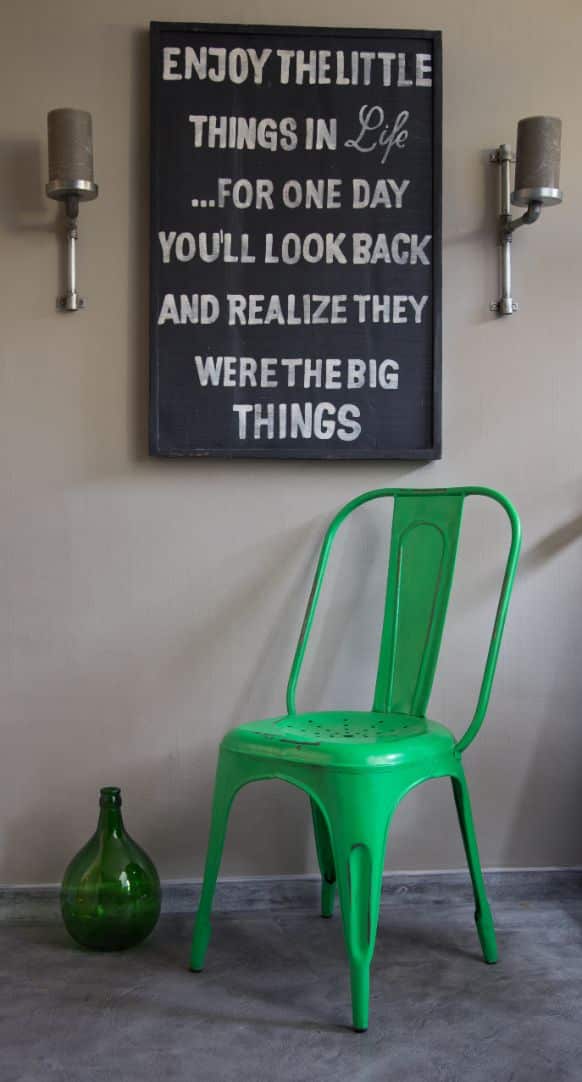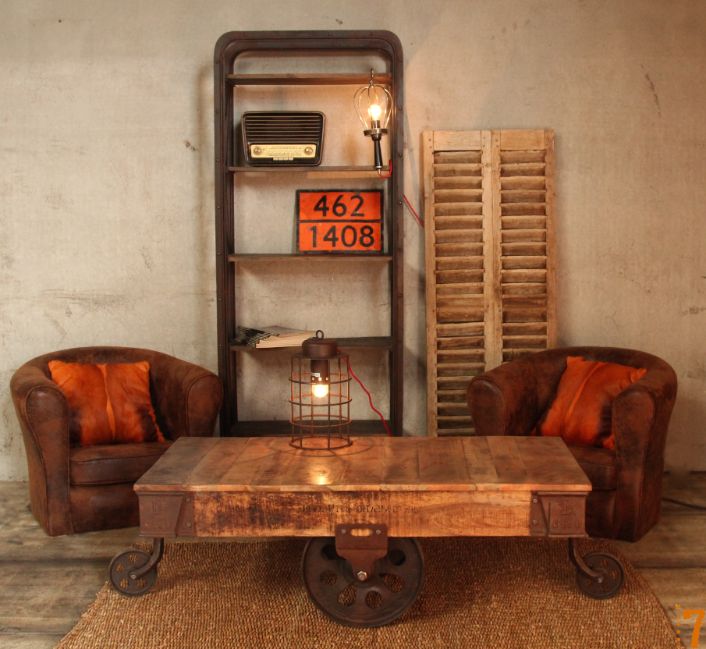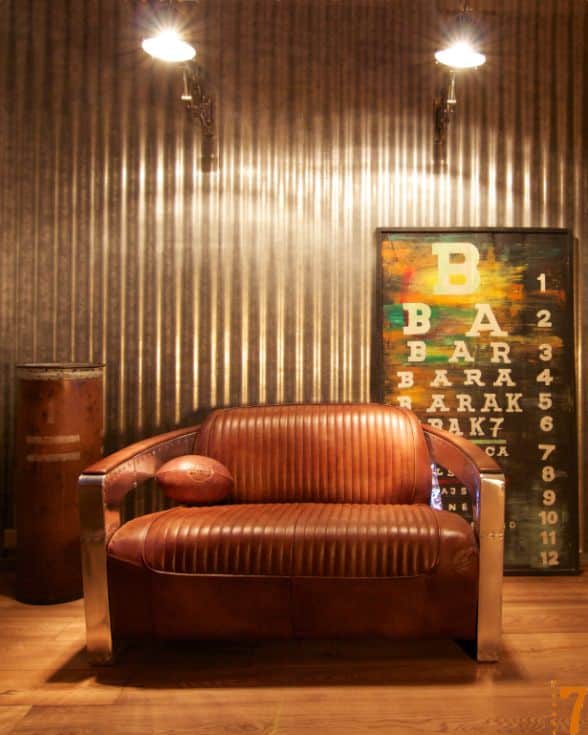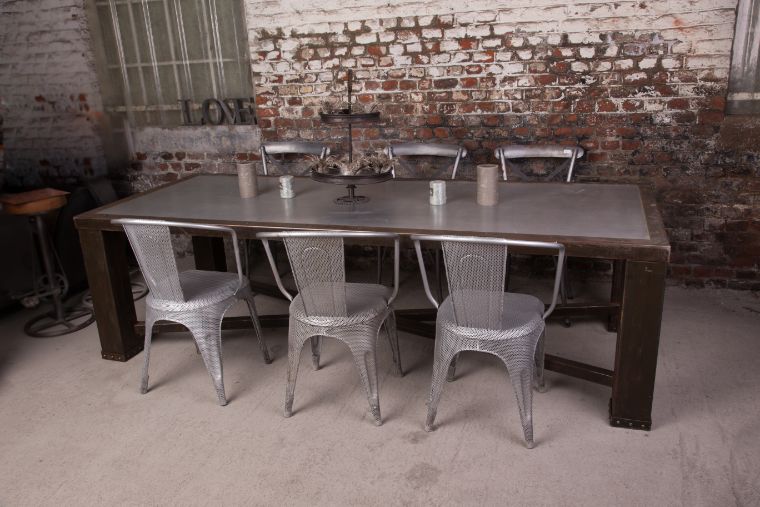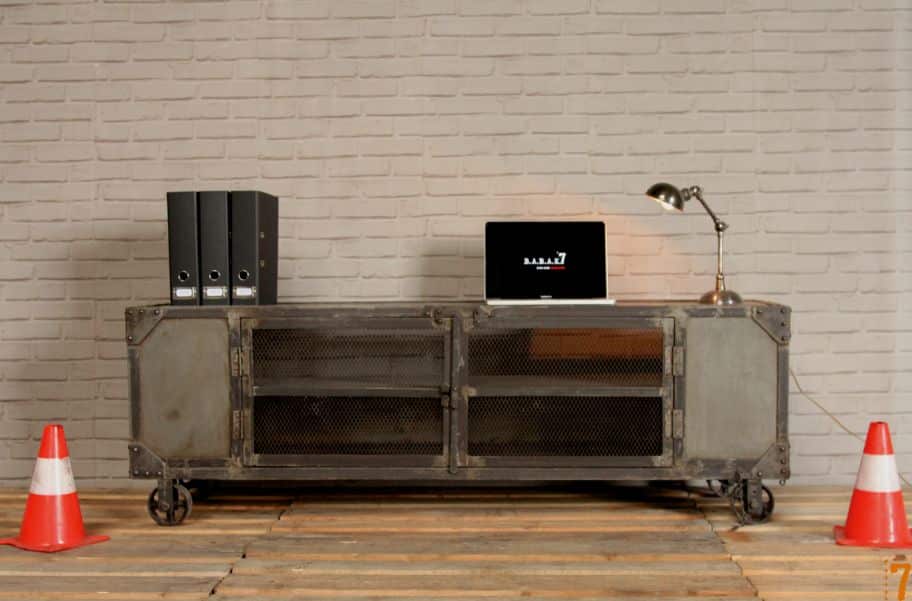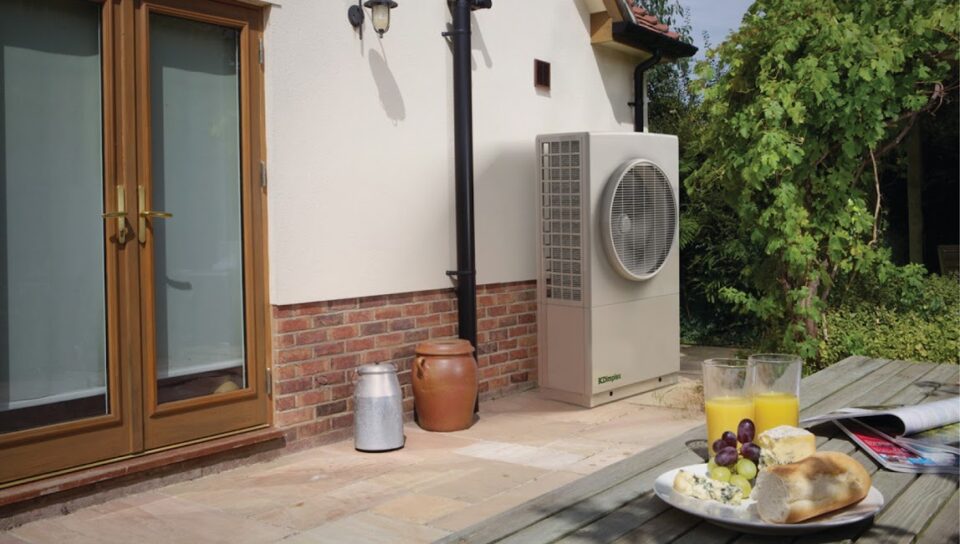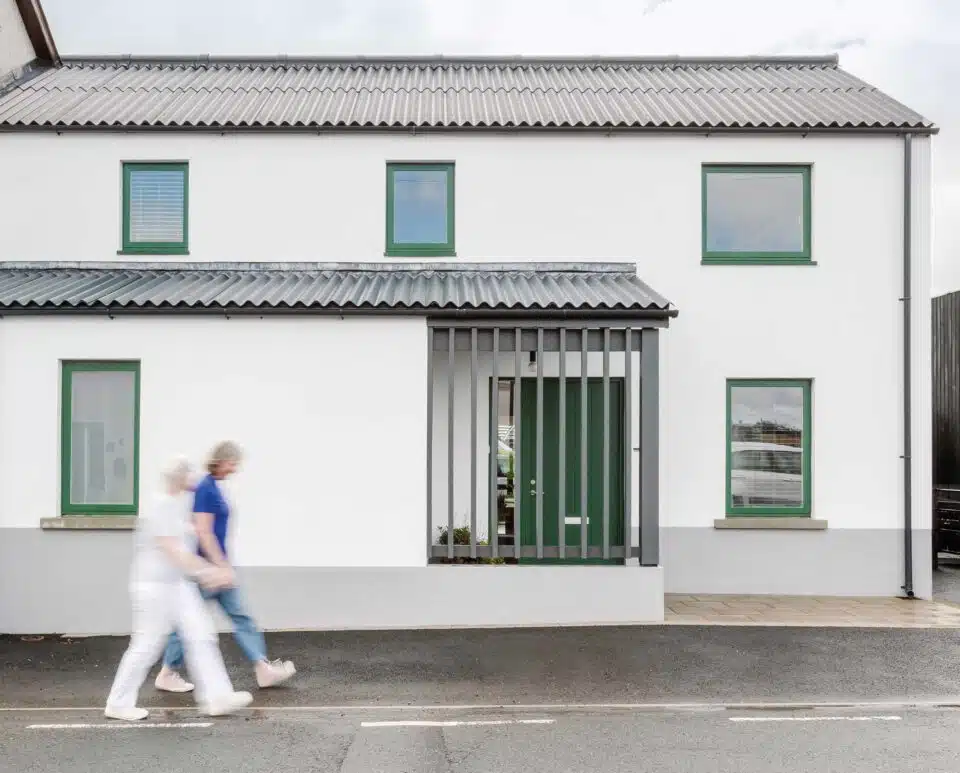In this article, industrial furniture maker Coralie Verheyden walks us through living without skirting boards or architraves, including:
- How to achieve the concrete chic look
- What colours to use and what textures
- How much it costs to choose this interiors style: savings in second fix vs investing in statement pieces
- How to get started in your home: step by step guide
- How to get the look in all areas of the home, from kitchen to bedroom
- Main pitfalls and how to work the look within any type of house design
- Photographs for inspiration
Simply put, the industrial look is raw and unadorned. In my mind the style mixes three basic ingredients: concrete, metal and wood with metal being the key component you can’t do without.
All of the constituent parts need to have been pre-loved, or appear to have been. The wood can’t be new: it needs to have a rustic or vintage feel to it. Other commonly used materials include well-worn leather and salvaged clay bricks.
You can buy new but that is the exception, e.g. wallpaper that looks like metal which is very tactile and makes a huge impact when you walk into a room.
The great thing about the industrial style is that it can, and should, be imperfect – the rawer the better! The central idea is functionality, each item has a role to play, and showing how it’s made or how it performs that function, in an understated way, is what it’s all about.
Some aspects that may not seem to be quite finished can be allowed to show through. This means for instance the ventilation and electrical conduits can be left exposed, walls left uneven with blockwork showing. And it’s perfectly ok to mix designs from different eras, in fact it’s all of these imperfections that add interest, warmth and personality to the industrial look.
In terms of colour, light grey is dominant. You will generally have concrete as your floor finish so that sets the tone! But remember to install underfloor heating, you want to have a warm space to walk on to make it cosy. Very common also are carbon grey, and white or off-white which is used to provide contrast and brighten up the space.
How much does the concrete chic look cost?
While single-ticket items can be expensive if you invest in high quality refurbished pieces, the industrial style is actually a cheap interior design alternative.
There are no skirting boards or architraves, no fancy plaster or mouldings/covings, the structural elements are in large part left exposed (no boxing-in) so there’s a lot less to spend on second fixes than you would in a traditional build.
However you cannot leave too much exposed; you don’t want to overcrowd your senses with absolutely everything being on show. There are a lot of services running through a house! So while some of the cabling and pipes will have to be chased/hidden, if building new think about which ones to display, e.g. some copper piping, and plan accordingly.
In terms of the fit-out, most items will be second hand which means they’ll generally be free or inexpensive. For instance you can use crates for shelving, wood pellets or old floorboards for wall coverings, old shutters for a headboard.
The most valuable thing to invest in is elbow grease! Once you find the perfect piece of wood or metal, you’ll probably have to give it a going over before you can put it in your home. In many ways it’s as much about the process as it is about the finished product.
My kitchen for instance was bought in kit form, black in colour, and to inject style I added old handles and covered the units with a custom-made riveted metal worktop, which was relatively inexpensive to make and is the centrepiece of that room. I thought the air extractor was ugly so I covered up the hood with wooden crates that cost me just €30!
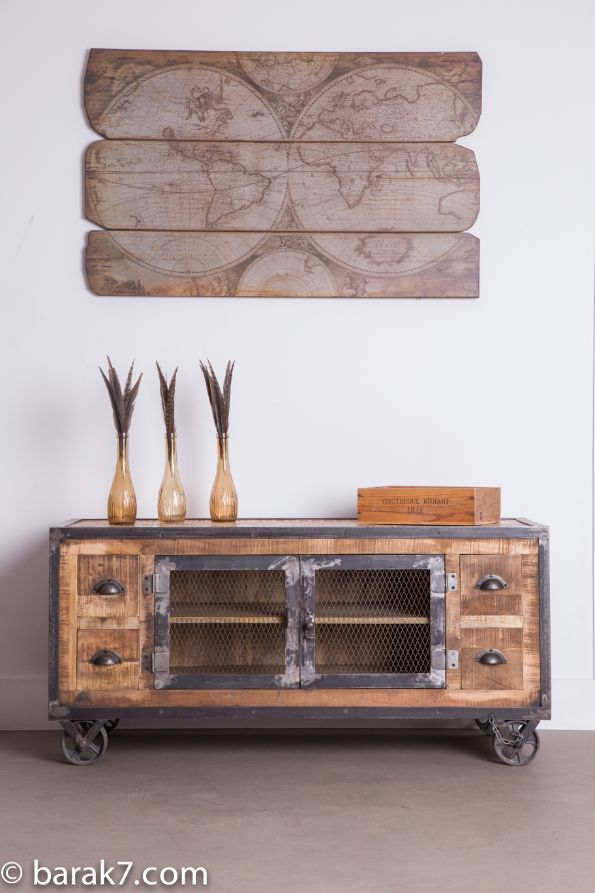
Where do I start?
Despite the apparent coldness afforded by the concrete and metal, the experience of living in your house should be organic and tactile and the interior design should reflect your personality and tastes.
There are many variations of the industrial style and you can choose to go in any direction, the main thing to remember is to have fun with it! It’s all about adding old fridge handles to a piece of furniture, grafting on castors to a side table or simply staining it. And don’t be afraid of the raw element, it will work to your advantage.
In all cases there should be one key piece of furniture in each room that sets the tone, it has to be the one item your eye is drawn to when you come in. I’d recommend either something completely metal or a wood/metal combo – that’s always a winner. You can then start softening the ambiance by layering in the wood.
Remember, as your eye sweeps across the room it needs to find things that provide warmth. Look in every direction – you can hang flower pots from the ceiling, for example, or add a small cosy rug in front of the couch.
The rest of the furniture should provide reminders of the central piece, this could be an old sign or a lamp that has similar colours, materials or continues with a common theme. Letters are popular too, individual metals ones or in the form of eye charts.
What if I want to add colour?
While this type of design does heavily rely on greys (on average in about 50% of the space), you still have plenty of room to play around with colour.
Rust from an old sign or really flashy colours that have mellowed over time are both hot favourites at the moment. If you choose to go for a very strong colour, use it sparingly and don’t use too many to avoid them clashing.
Some pieces of furniture will go better with certain colours, so the choice will in large part depend on what your centrepiece is in that particular room.
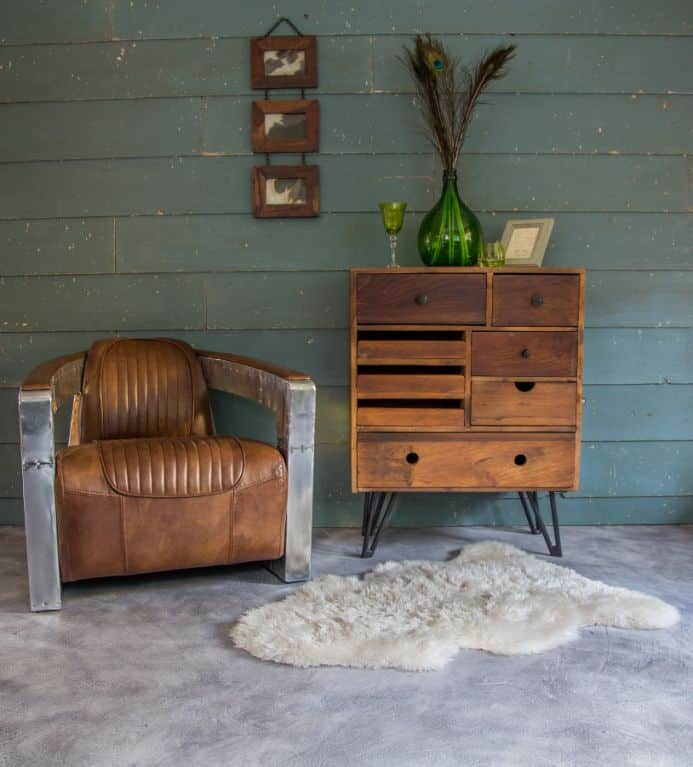
Are there specific things to consider in different rooms?
All of the rooms in your home can achieve a cosy feel with the industrial style although it is true that I prefer to stick with whites and neutral colours in my bedroom, which are complemented by the use of wood and my metal bedside table. Even my sheets abide to the rule ̶ plain khaki, light grey and white are my colours.
That said, if it’s your inclination to do so you can add some strong notes of colour, even tartan patterns are popular at the moment. But in that case go easy on the rest of the items in the room – you don’t want to have too much going on.
In the office you can allow the electrical cabling to show for instance, and add exposed light bulbs at different heights. In the living or dining rooms consider suspending light pendants at different heights using chains, leaving the cables exposed.
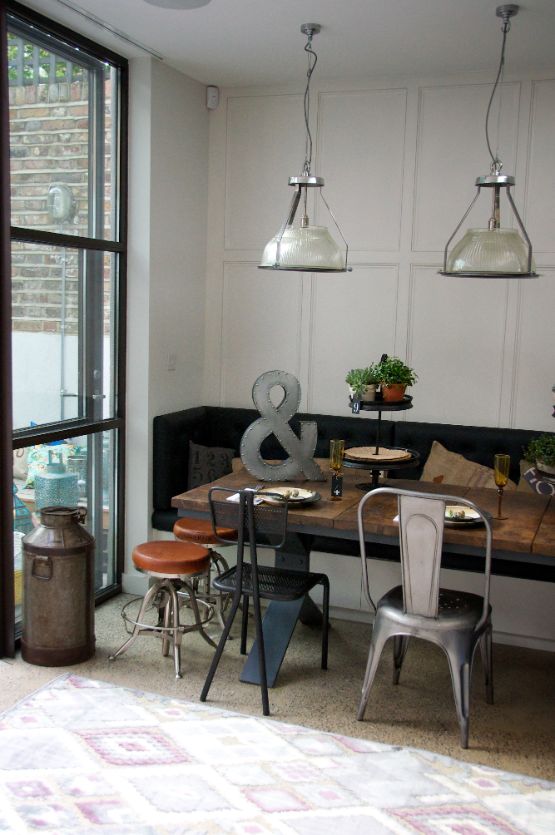
My house doesn’t exactly resemble a New York loft, are some houses not suitable for the industrial style?
There are few spaces that couldn’t accommodate it. That said in interior design you do need to aim for a harmonious space so your doors, windows, floor, all need to speak to each other. If something doesn’t gel, you’ll need to change it. More often than not this will simply mean replacing door handles or layering in shades of grey.
For instance when I moved into my apartment it was full of gilded mouldings – I whipped out the spray can and painted them a matt black colour (admittedly after a lot of hard work stripping them down!). I then proceeded to oil and wax the wooden floor to give it some age.
Windows are much trickier to get to blend in and they’re expensive to replace. Ideally you’d have a metal or timber frame, but if you do have uPVC consider painting it to match the kind of industrial look you adopted. Otherwise make it seem like they were installed on purpose! Plastic can work as an industrial theme, you could consider adding Vitra chairs for instance or a retro Formica table with metal legs.
What are the pitfalls to concrete chic and how can you avoid them?
In terms of materials, metal and concrete can be quite cold so it’s a good idea to counteract that with a warm lighting scheme, avoiding neon or high wattage bulbs. You can find LEDs now that provide that warmth in colour.
Furniture made of these materials can also tend to be bulky and quite heavy-looking so to lighten up the style consider the space as not only the floor area but as a volume. You can soften the rough feel by hanging a flowered plant, for example, or a suspended light. Breaking the uniformity of the straight lines is important to make the house feel cosy which is where colour can also step in.
To keep the theme going, don’t try to cram in too much furniture in one room; you need each item to be given enough room to shine. Clutter just doesn’t work with the industrial style.
Generally avoid buying new, even if it’s a copy of a vintage piece of advertising. What you want to achieve is that worn, pre-loved feel, so hit up the salvage yards and websites selling second-hand goods. It’ll be cheaper too!
And if you choose to carpet the floor (not usually recommended!) make sure it’s not patterned and the colour is neutral.
Last but definitely not least, the industrial look can be as much about stripping down as it is about covering up – you need to get a feel for when it’s appropriate to do either of the two.
For instance, if you have the budget you could overlay your plastic plumbing pipes with copper or brass to add that extra layer of class. The rule of thumb is to only leave ducting exposed if it’s attractive so think raw metals such as zinc or even simple metal ducting.
